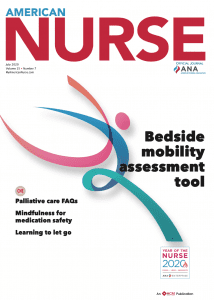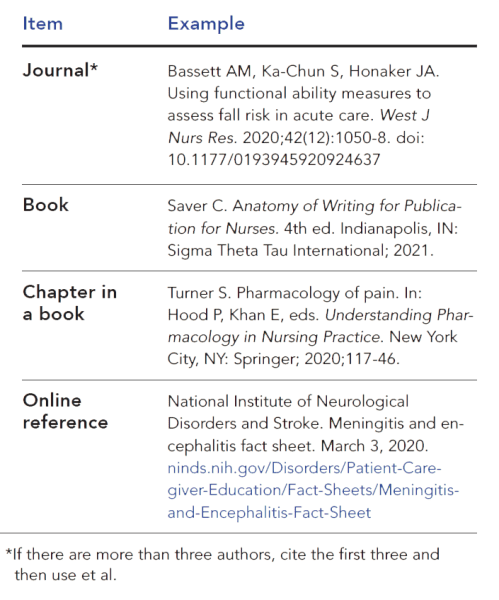American Nurse Journal, a peer-reviewed journal published by HealthCom Media, is dedicated to integrating the art and science of nursing. As the official journal of the American Nurses Association, it serves as an important and influential voice for nurses across the country. The journal is committed to delivering authoritative research translated into practical, evidence-based literature and relevant content to keep nurses up-to-date on best practices, help them maximize patient outcomes, advance their careers, and enhance their professional and personal growth and fulfillment. If you’re considering writing for us, use these guidelines to help choose an appropriate topic, learn how to submit your manuscript, and improve the likelihood that we’ll accept your article for publication.


Journal profile
Overview: American Nurse Journal is a peer-reviewed journal that provides a voice for today’s nurses in all specialties, all practice settings, and all organizational levels. Packed with practical information, it keeps nurses up-to-date on best practices, helps them maximize patient outcomes, and enhances their careers.
Distribution: The journal is sent to 200,000 nurses who work in various settings and specialties, including staff nurses, advanced practice nurses, managers, educators, researchers, and administrators.
Indexing:American Nurse Journal is indexed in the Cumulative Index to Nursing and Allied Health Literature (CINAHL) Database.
Editorial profile
Overview: By transforming authoritative research and clinical data into clearly written prose, American Nurse Journal provides evidence-based information that readers can apply daily in their practice. It also serves as a forum for the discussion of professional development and career management issues.
As part of our commitment to enhancing readers’ professional and personal growth and fulfillment, we also publish articles that guide nurses toward living healthier lifestyles and managing stress effectively.
American Nurse Journal offers compelling feature articles on clinical and professional topics, plus continuing nursing education (CNE) articles. Regular departments include:
- Healthy Nurse
- Leading the Way
- Life at Work
- Practice Matters
- Strictly Clinical
- Working Smarter
Listen to the Podcast below to learn more about Writing for Publication in Nursing:
Novice Writers FAQ's:
Author query (optional)
Please send a brief email query to jnyhus@healthcommedia.com. In the email:
- Describe the topic of your proposed article, including why it would be of interest to readers of American Nurse Journal.
- Briefly outline key components of the article.
- Briefly explain why you’re qualified to write on this topic.
- Provide your name, position title, employer, and phone number.
We’ll let you know if we’re interested in the article you’ve proposed and provide advice for focusing it.
Tips on writing for American Nurse Journal
Articles for our journal are written in informal, concise language. When writing the manuscript, follow these guidelines:
- Base your information on the latest nursing standards and clinical practice guidelines.
- Be clear and concise; avoid convoluted sentences.
- Provide examples and practical points that can be readily applied to practice.
- Address readers directly, as if you’re speaking to them. For example: “After turning on the power, connect the tube….”
- In general, use active—not passive—verbs. Active verbs engage the reader and make the writing simpler, clearer, and more interesting.
Examples
Sentence with passive verb: Heart rhythm should be monitored closely. Avoid this type of sentence.
Sentence with active verb: Monitor heart rhythm closely. Use this type of sentence instead.
- Clearly explain theoretical or complex terms in everyday language. Avoid medical and nursing jargon.
- Don’t use acronyms or abbreviations, except those you’re sure every reader is familiar with (such as “I.V.”). Instead, spell out the full term.
- As appropriate, use trailing zeroes for diagnostic test results, as in “urine pH 5.0.” However, Do NOT use trailing zeroes for drug dosages; for example, use “15 mg,” NOT “15.0 mg.”
- Use generic names for medications.
- Consider using boxed copy (sidebar) for points you’d like to emphasize, clarify, or elaborate on. Also consider putting appropriate information in tables (using Microsoft Word).
Resources for new authors:
- Redulla R. Writing clinical articles: A step-by-step guide for nurses. Am Nurse J. 2022;17(5)24-6. myamericannurse.com/writing-clinical-articles-a-step-by-step-guide-for-nurses
- Saver C. Anatomy of Writing for Publication for Nurses. 4th ed. Indianapolis: Sigma Theta Tau International; 2021.
- Saver C. The Writing Mind. myamericannurse.com/category/the-writing-mind/
- Nurse Author & Editor.
Our readers appreciate timely topics relevant to hands-on nursing care in all settings, as well as current professional and leadership issues. In particular, we’re seeking articles that:
- present evidence-based clinical information
- discuss recent developments, such as new treatments, procedures, or diagnostic techniques
- provide step-by-step descriptions of new or difficult clinical procedures
- discuss new drugs or new drug regimens
- explore the legal and ethical issues that nurses face
- address important professional and career issues
- share strategies to improve patient safety and the quality of nursing care through best practices
- explore controversies in nursing and healthcare
- help nurses influence decision-making in their practice environments and organizations
- discuss how to better leverage technology to improve patient outcomes
- offer advice on enhancing mental, emotional, and spiritual well-being.
Use the following as a rough guide (word counts include tables, but not references):
- Continuing education article: about 3,300 words
- Feature article: about 1,800 to 2,800 words
- Department article: about 1,000 to 1,500 words.
- Note: Rapid Response articles should be no more than 600 words.
List all references in alphabetical order at the end of your manuscript. Do NOT use Microsoft Word footnote function. Limit in-text citation to statistics, specific study findings, and significant statements from credible sources. Use a format such as:
- According to the Centers for Disease Control and Prevention, cigarette smoking causes more than 480,000 deaths annually.
- A study by Jones and colleagues found that …
You only need to provide sufficient information for readers to identify which reference matches with the information in the main text. References must be from professionally reliable sources and should be no more than 5 years old unless they are “classics.”
To format the references in your list, use the American Medical Association Manual of Style: A Guide for Authors and Editors (10th ed). If you don’t have access to this book, simply follow these examples:


Please limit the number of references to no more than 12 (20 for a CNE article).
We encourage you to submit tables and figures for your article (although publication isn’t guaranteed).
Figures
- Submit each figure in a separate electronic file, labeled with the number and brief name of the figure. For example: “figure 1, venous thrombo embolism.”
- In the text of your article, note where the figure should appear. For example, “Insert figure 1 here.”
- Place the names of the figures at the end of the article, and include a brief caption and the source for each. For example, “figure 1: venous thrombo embolism. From American Cardiovascular Association, 2020.”
- Submit images that go with figures as JPG files, with resolution 300 dpi at 4.5 inches wide.
- Save files of diagrams, drawings, graphs, and other line art at a resolution of at least 1200 dpi. If these were created in a Microsoft Office program, please send the native (DOC, PPT, XLS) file.
Tables
- Put tables at the end of the document.
- Number each table and include a name and a brief introductory statement. For example,
Table 1. Risk factors for venous thromboembolism
Early identification of risk factors is crucial in preventing venous thromboembolism.
- In the text of your article, note where the table should appear. For example, “Insert table 1 here.”
Note: The author is responsible for obtaining permission for reprinting tables and figures from another source. If there is a fee, the payment can wait until after the article is accepted; simply note that you will obtain permission. If you have already obtained permission, please submit verification with your article.
Submit in Microsoft Word. Other formats will NOT be accepted.
- Put the article title, your initials (not your name), and the date at the top of the first page of your article.
- Do NOT include extra hard returns between lines or paragraphs, extra spaces between words, or any special coding.
- The manuscript submission process is electronic. Please visit myamericannurse.com/submit-a-manuscript to submit your manuscript and additional materials.
- Please note that you will be asked to sign documentation including the author agreement and disclosure of conflicts of interest.
- If you have additional authors, you will be asked to supply their names during the submission process. You will be provided with a code and a link to share with your coauthors after you complete the submission. They can then submit their author agreements and disclosure of conflicts of interest via the link.
Manuscripts are 1,200 – 1,800 words, not including references. Focus the content on challenging assessment and clinical topics.
Include the following:
- Short anatomy and physiology section (no more than 500 words)
- Application to practice
- Nursing implications
Format options:
- Frequently Asked Questions: Use the FAQ format (with questions as subheads) to engage the reader.
- Case Study. Introduce the topic with a short case study and conclude with patient outcomes. Applying the topic to a case presentation helps the information come alive for the reader.
Research shows many patients exhibit signs and symptoms of increasing instability for several hours prior to a cardiac arrest. A Rapid Response Team, generally critical care specialists, intervene before a potential code situation, based on the bedside nurse’s sensitivity to a patient’s deteriorating condition and call to action. A Rapid Response article is designed to give the nurse the assessment, critical thinking, intervention and communication skills needed to respond appropriately and effectively.
Below is the format for Rapid Response. Address each point below, with the total word count around 600 to 650 words, not including reference. Typically, the scenario will take place in a non-acute care setting, such as a med-surg unit, labor & delivery, orthopedic unit, and the like.
- Describe the series of events/assessments from the nurse’s perspective (include diagnosis, hospitalization status, and any significant history issues), beginning with the first encounter until the call for a rapid response. Be sure to start with vague complaints, including a valuable assessment finding, if possible, that makes the nurse more concerned and warrants a closer follow-up (nurse’s intuition).
- As the patient’s condition worsens, describe the nurse’s actions taken to modify her assessment, increase surveillance, (intervene or treatment steps until team arrives) touch base with the PCP, and other measures demonstrating critical thinking and communication skills.
- Include detailed step by step intervention/treatment steps that were taken by you or the RRT to derail further deterioration including drugs, doses, routes, etc.
- Provide an outcome/explanation for the scenario with the patient either stabilizing or being transferred to the appropriate acute care setting (ICU, CCU, OR).
- Give a brief overview of the issue that threatened, e.g.. as in anaphylaxis – what it is – how it occurs, etc.—what could have happened if you did not foresee, treat, etc. Please keep explanation short to paragraph or so.
- Offer patient/family education–or even for the reader (such as clues to assessment findings or lab values)
Again, the scenario doesn’t always have to be about a nurse calling the Rapid Response Team, but it should demonstrate how the nurse’s assessment skills, intervention, critical thinking abilities and effective communication contribute to positive patient outcomes.
Sharing your quality improvement (QI) projects helps your colleagues and their organizations take steps to enhance care, engage nurses, and advance the nursing profession.
When structuring an article about your QI project, you want to create a clear path that other nurses can replicate. The following format helps readers understand the general topic, the challenge or problem you faced, the research you conducted to learn more, the implementation steps you took, and the outcomes you achieved. Be succinct, avoid jargon, and use active voice to engage readers and ensure they gain as much practical knowledge as possible.
What’s the overall issue?
- Example: “All organizations work to prevent catheter associated urinary tract infections (CAUTI).” Include a few statistics on the topic to provide context. (Keep this section brief—no more than one to two paragraphs. Readers likely know this information, but setting the stage helps highlight the relevance of the topic to a broad audience.)
What was your specific challenge?
- Example: “The surgical oncology unit in our community hospital saw an increase in CAUTI from May 2020 to May 2021.” Provide a few details on that increase and describe initial steps, including, if applicable, the formation of a committee (for example, “We formed a committee that consisted of the unit manager, a nurse educator, and two staff nurses.”) to investigate the problem and devise a solution.
What research did you conduct?
- Example: The CAUTI committee conducted a literature review to uncover best practices. (Keep this section brief. Don’t go into detail about each step of your research. Instead, highlight the information that seemed most relevant to your specific challenge.)
How did your project work?
- Tell the reader who did what (“The nurse educator created a learning module [describe the module components]. The unit manager collected and analyzed participant feedback [describe how this collection was done—pre- and post-implementation, via email, etc]. The staff nurses tracked CAUTI incidence [describe how they did this, over what period of time, and how it was analyzed].”)
What has been the outcome?
- Provide pre- and post-implementation data showing effect, if possible. Include information about any challenges or limitations you encountered.
What’s the return on investment?
- How much did the project cost in terms of time, supplies, etc. compared with the benefits achieved?
What are potential problems?
- Let readers know of potential pitfalls if they want to implement the program. Be honest about any difficulties you had that others could learn from.
What is other key advice for the reader interested in implementing the program?
What are the key implications for nursing?
- Include a summary and thoughts on use in nursing practice and next steps. If you believe more research is needed on this topic, say so.
Where can readers get more information on the overall topic and best practices?
If you are interested in sharing your opinion, you might consider writing for our Perspectives blog. Articles are 600 to 1200 words long and are not peer reviewed. With our new submission process, authors can select submit the manuscript through the online submission process and select Blog/Perspectives in the drop-down menu in the “Preferred Category.”
- American Nurse Journal adheres to the principals stated in the Committee on Publication Ethics (COPE) Guidelines, which can be found at publicationethics.org/guidance/Guidelines
- The article must be your own original work. Do not submit material taken verbatim from a published source, except for brief passages, which you should put in quotes and attribute to the source.
- Manuscripts submitted to ANJ must not have been previously published or be under consideration for publication in another journal.
- In accordance with the International Committee of Medical Journal Editors, all listed authors must have made substantive intellectual contributions to the manuscript “without which the work, or an important part of the work, could not have been completed or the manuscript could not have been written and submitted for publication.” In particular, authors should read about Roles and Responsibilities at icmje.org/recommendations/browse/roles-and-responsibilities/defining-the-role-of-authors-and-contributors.html
- Authors must disclose real and potential conflicts of interest.
- ANJ editors concur with the Committee on Publication Ethics position statement on authorship and AI tools, which reads, in part, “Authors who use AI tools in the writing of a manuscript or in the collection and analysis of data, must be transparent in disclosing how the AI tool was used and which tool was used. Authors are fully responsible for the content of their manuscript, even those parts produced by an AI tool, and are thus liable for any breach of publication ethics.” Read the full statement at https://publicationethics.org/cope-position-statements/ai-author.
- We will confirm receipt via email.
- Manuscript is reviewed by the editorial team. Note that all author agreements and conflict of interest statements must be submitted before internal editorial review can begin.
- If we’re interested in publishing your manuscript, we’ll send it for double-anonymous peer review (authors and reviewers do not know each other’s identity). Peer reviewers are selected based on their areas of expertise.
- After peer review, we’ll let you know whether the manuscript has been accepted, rejected, or recommended for revision.
- If accepted for publication, your article will go through our standard in-house editorial process to ensure adherence to our editorial style. Before it’s published (in print and/or online), you’ll have the opportunity to review the edited version.
Thank you!
Thank you for your interest in publishing with American Nurse Journal. In order to streamline your submission, we have developed an electronic submission process. You can upload your manuscript, additional files, and complete all the essential documentation. Be prepared to sign the author agreement and conflict of interest disclosure via the electronic submission process. Click here to preview the author agreement and conflict of interest disclosure.
If you have any questions, please contact Julie Nyhus, MSN, FNP-BC, APRN, Editorial Director, at jnyhus@healthcommedia.com.
After you have a manuscript published – here is information on how you might further disseminate your work:

